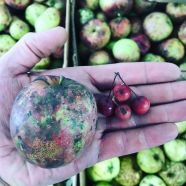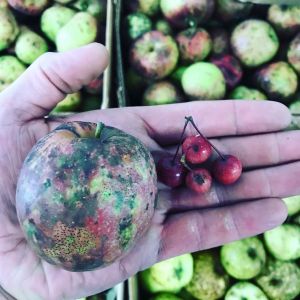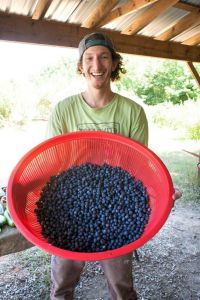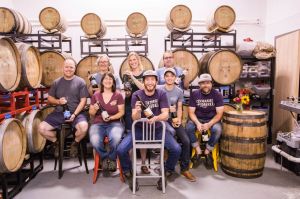A Modern Spin on Nature’s Desire
“I am drinking the stars.”
—Dom Pierre Pérignon, Benedictine monk (1638–1715) on his first sip of sparkling Champagne
Nature vs. Nurture
Yeast and bacteria have been a part of the human experience from the beginning of time. I often wonder what that first bite of fermented fruit, with its touch of alcohol, must have been like. Did these people share the discovery or keep it to themselves for a while?
In modern commercial alcohol production, fermentation is something to be manipulated and controlled. Labs grow yeast to precise specifications. Fruits are pasteurized, filtered, and sprayed with chemicals. They are stripped of their true beauty and character, rendered into combinations of letters and words. Just another ingredient on a label.
But found in the fringes, in small wineries, in small batches, there are those who know nature does some of its best work when allowed the space and time to work. Nature has had millions of years to practice and evolve. In these places, native yeasts multiply, but fermentation is not rushed. It’s not a race to the shelves of stores, but instead a show of individuality. Fruits are harvested whole and untouched and we see a return to simplicity; where imperfection is perfection; where a sense of place, terroir, is valued; and where each bottle tells a story. It’s a story of the soil, in that vineyard or orchard, the soul of the land and the hands that bring it all together with love.
Beauty Is in the Eye of the Beholder
Over 30% of all food grown worldwide is thrown away. This is a tragedy. As a society, we have trained ourselves to want perfectly symmetrical and unblemished fruits. Same as life, “real” fruit is not always pretty and is labeled “ugly fruit” because of blemishes, curves, and crevices. I say it is perfectly imperfect. If commercial farms didn’t use herbicides, pesticides, and fungicides, that perfect looking apple we see in our grocery store would be the outlier.
From the point of view of taste, commercially grown apples can be drab when compared side by side with a “real” apple. This is the result of creating the least amount of stress possible for trees. While this sounds like the right course of action, stress creates superior fruit. Irrigated fruit tastes less intense because they are diluted with water. Vineyards and orchards with low yields that choose to limit inputs in the fields grow fruits dripping with flavor that reflect their soil’s makeup.
So, why do we care? A big part of the problem with waste is what we do with it. Some “ugly” fruit ends up in animal feed, some in bulk pasteurized juice, and some in the compost pile. It requires a lot of input, time, and labor to grow food. Working toward finding a suitable home for these fruits is an important step toward sustainability.
The Greatest Good: Organic or Local
Should organic food from South America/China be preferred over conventional food from down the road? Which is more environmentally friendly? Rather than putting organic food on a pedestal, I prefer to put local food on a pedestal. Inputs are at the core of the debate. Shipping food across countries is incredibly energy intensive and the resulting nutrient content is lower. In fact, it’s more environmentally friendly to get wine from Europe if you live on the East Coast than California. This is because floating wine on a boat is much less energy intensive than trucking it 2000+ miles across the US. To ship food from afar, growers often have to pick it before it’s ripe and hold it in specialized gas containers to control ripening so it arrives to grocery shelves in perfect “looking” condition but stripped of its full nutritional value. Local food is picked when it is ready and delivered within a day or two, at its full potential. Whenever available, local and organic is the best option and should be sought out. Local food also supports your local economy while building a sense of community. In a postpandemic world, it’s easy to see why improving our local food supply infrastructure is important and must be improved upon.
To Input or to Output?
“Pollution is nothing but the resources we are not harvesting.
We allow them to be dispersed because we’ve been ignorant of their value.”
—R. Buckminster Fuller
The FDA allows more than 75+ additives to wine. Sulfites, velcorin, sorbate, polyoxyethylene, ferrocyanide(s), milk powder . . . (you get the point). While many are benign, some contribute to the sulfites headache myth, when in fact the additives are the culprit. (There are more sulfites in a glass of OJ than wine, and, although anecdotal, I’ve never heard anyone get a headache from a glass of OJ). So why do some wine producers add so many compounds? It’s simple; maximum predictable output.
Let’s take another look at a federal regulation to find the answer. Every winery files a report tracking every drop of juice in and every drop out. If you have more than 3% difference of juice in versus juice out you have to file an additional form explaining the loss; 3% loss hardly covers the loss from what is called “angel share,” which is the loss due to evaporation. Our wineries experiences an average loss of 7% each year. To achieve this low level of loss a wine producer has to filter, fine (the process of adding a substance—a fining agent—to the wine to create an adsorbent, enzymatic, or ionic bond with the suspended particles, producing larger molecules and larger particles that will precipitate out of the wine more readily and rapidly), and clarify the wine to remove any solids or dead yeast. Commercial producers use additives to clarify and purify, which make for predictable and replicable products that consumers can expect to be exactly the same every time. Further, many additives are required by law to be removed from the finished product, so you add something to take it away. In this process, you’ve created waste for the landfill or the sewage treatment plant.
Commercial wine has become so process-oriented that the end product of one winery can oftentimes be indistinguishable from another winery.
Packaging Matters: Bottles, Cans, Kegs, oh my!
This topic is hotly debated in the beverage community. Single-serve packaging is where fashion, politics, business, and environmentalism meet. Perceived value and consumer willingness to pay compete against common sense and true cost. If the same wine is packaged in a bottle or a can, people are willing to pay much more for the bottle. The wine inside is the same, exactly the same, but our minds and marketing convince us that it’s not true. There are authoritative articles looking at just this issue and they tell us that recyclable aluminum cans are the best options for packaging when the full costs of transportation and manufacturing of each format are fully factored. Serving wine as a draft from reusable stainless steel kegs is the clear winner because waste is at a minimum, but this only works on the local level.
Can Alcohol Be Healthy?
Alcohol in moderation is a beautiful thing. Too much alcohol can do serious damage to your body. We’ve explored additives in the wine and in the orchard. We’ve talked about wild yeast cultures. What does this mean for our bodies and long-term health? We believe drinking unmanipulated alcoholic beverages in moderation can be good for your body and mind. Wild cultures can help your gut. Polyphenols found in wines, such as resveratrol and quercetin, work as antioxidants in the body. You’ll also find some vitamins and minerals in wine, such as vitamins B6, C, and K. Well-made unpasteurized and unfiltered beverages have a plethora of nutrients and antioxidants.
Putting It All Together: From Ground to Table
The day I fell in love with wine, I was sitting in a basement Italian restaurant in New York City. It was dark and mysterious, and the food was delicious. I was nervous and exhausted. I was the youngest and least experienced person at the table, “green” as they say. I had just flown from my home in North Carolina earlier in the early morning with a group of sommeliers and wine pros. As we sat around a big table tasting wines from all over Europe, I had a sip of a wine and, for the first time, I understood how people become obsessed with wine. In that moment, it happened to me.
Wine is alive. Wine is created without help from humankind as fruit ferments on vines, trees, and bushes naturally. When wine is made with respect and love for its particular “nature,” the wine will love you back. It can show you the world through a new lens with each bottle, with each sip. It is a snapshot of a time and place, a journey in a glass. That is terroir.
I love cider and wine, and I felt my region of the South could fulfill its true potential by producing natural ciders and wines that let its terroir shine. So, in 2016, along with my wife, Amie, my sister Kether, and brother-in-law Deric, I helped start the South’s first and only natural cidery and winery, in Cedar Grove, North Carolina.
At Botanist & Barrel, we let nature run its course. We embrace wild spontaneous fermentation. Each barrel we release is unique with its own “fingerprint” if you will. It’s a snapshot of fruit from particular fields, captured in a certain moment, with unique properties due to variations in wind, rain, temperature, and sunlight. It expresses the southern terroir, a sense of place. We have lower yields in the orchard and in the winery because we don’t use additives; but we have virtually no waste. What is commonly considered “waste” is applied back to the earth or used in other products. We seek out ugly fruit and have become a local hub for getting ugly fruit from farmers into the tanks of other local producers. We prefer local organic produce and buy local over organic if we have to choose. We are careful buyers. We work with farmers who care about what they are doing and who use minimal inputs, taking action only if it is absolutely necessary.
We want all the ugly we can get. A huge majority of what we use to make our ciders and wines are the seconds, culls, and ugly fruit. Even as a tiny producer, we use over 20,000 tons of ugly fruit a year. We package in bottles, cans, and stainless steel kegs. We let what the wine needs guide us to determine the package along with where it’s going. We don’t have fancy equipment in our winery. You’ll find no forklift, no automated systems. We are composed of only barrels and tanks, fields and a tractor, and our hands and hearts.
We are continuously working to become better stewards of our environment. We do our best to reduce energy use and material inputs at every stage of our process. We take this pursuit seriously and audit ourselves, seeking every opportunity to make the cleanest, healthiest, and most delicious beverages possible.
So the next time you pick up a bottle of cider or wine, consider where it was made and who made it. Consider not only how it tastes but how sustainably was it made and packaged? Pay close attention to how it makes you feel. Imagine the field, the wasp who unknowingly spreads native yeasts around the field, the farmer who nurtured the plant, the hands that carefully harvested and sorted the fruit, and the winemakers who gently guided the juice into a beautiful beverage. Consider the wisdom of the Greek poet Alcaeus: “In vino veritas” (in wine there is truth).











Hands down, the BEST read I have had in years! So genuine, informative and thorough..My heart is happy…
Fantastic read… II can actually taste the wine through this article!!! Love learning about the process and the sustainable model you have created! Can not wait to try your wine!